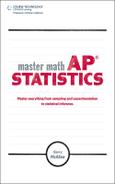Book Description
Get ready to master the concepts of AP Statistics and ace your exam! MasterMath: AP® Statistics is a comprehensive reference guide written specifically for AP Statistics students, covering all the topics of AP Statistics in a simple, easy-to-follow style and format. Suitable for a wide variety of ability levels, this book explains and clarifies the various concepts of AP Statistics including exploring data, sampling and experimentation, anticipating patterns, and statistical inference. The example problems in each chapter are written with the AP Statistics Exam in mind to help you understand the concepts and learn how to effectively answer the exam questions. You'll also find useful appendices that will help you prepare for the exam, including all the tables and formulas that are given and needed, as well as a quick-reference summary of assumptions and conditions for inference. A helpful glossary will help you brush up on terminology. Master Math: AP® Statistics is an invaluable resource for anyone studying and preparing for the AP Statistics Exam.
Table of Contents
- Copyright
- Acknowledgments
- About the Author
- Introduction
- Preparing for the AP Statistics Exam
- 1. Exploring and Graphing Univariate Data
- 2. Exploring and Graphing Bivariate Data
- 3. Normal Distributions
- 4. Samples, Experiments, and Simulations
- 5. Probability
- 6. Sampling Distributions
- 7. Inference for Means
- 7.1 The t-Distributions
- 7.2 One-Sample t-Interval for the Mean
- 7.3 One-Sample t-Test for the Mean
- 7.4 Two-Sample t-Interval for the Difference Between Two Means
- 7.5 Two-Sample t-Test for the Difference Between Two Means
- 7.6 Matched Pairs (One-Sample t)
- 7.7 Errors in Hypothesis Testing: Type I, Type II, and Power
- 8. Inference for Proportions
- 9. Inference for Related Variables: Chi-Square Distributions
- 10. Inference for Regression
- A. Tables
- B. Formulas
- C. Assumptions and Conditions for Inference
- One-sample t-interval or one-sample t-test
- Two-sample t-interval or two-sample t-test
- One-proportion z-interval or test
- Two-proportion z-interval or test
- Chi-square goodness of fit (one variable from one sample)
- Chi-square test for homogeneity (samples from many populations)
- Chi-square test for independence/association (one sample from one population classified on two variables)
- Regression (t)
- D. Glossary
